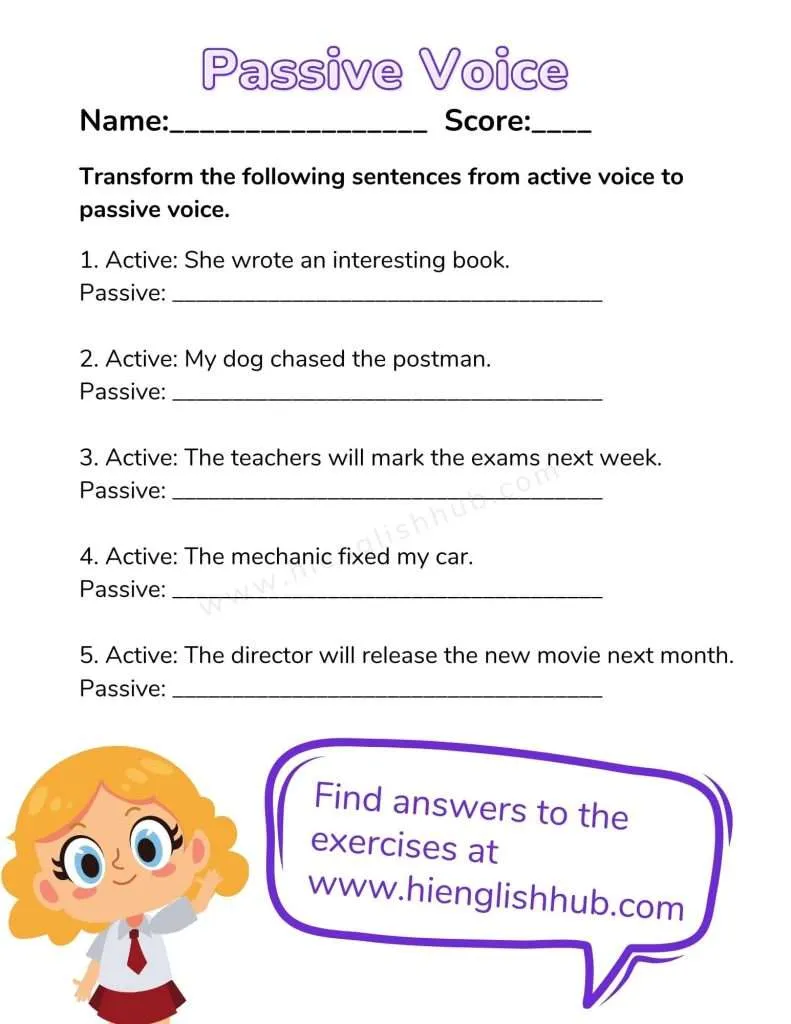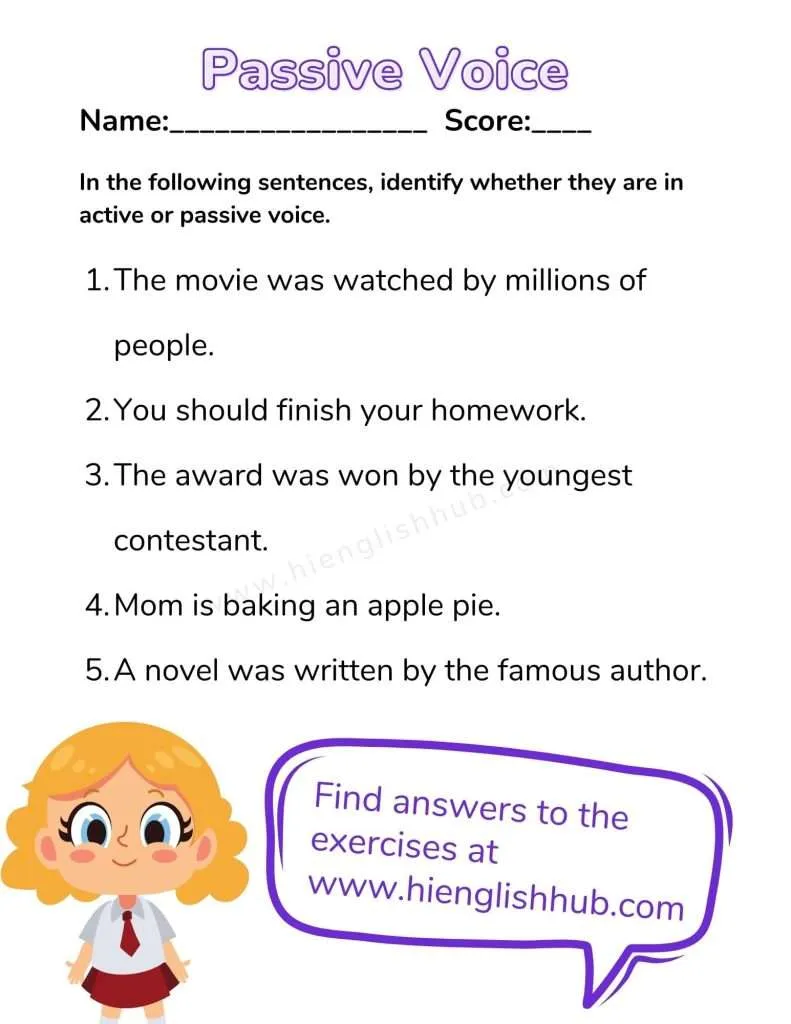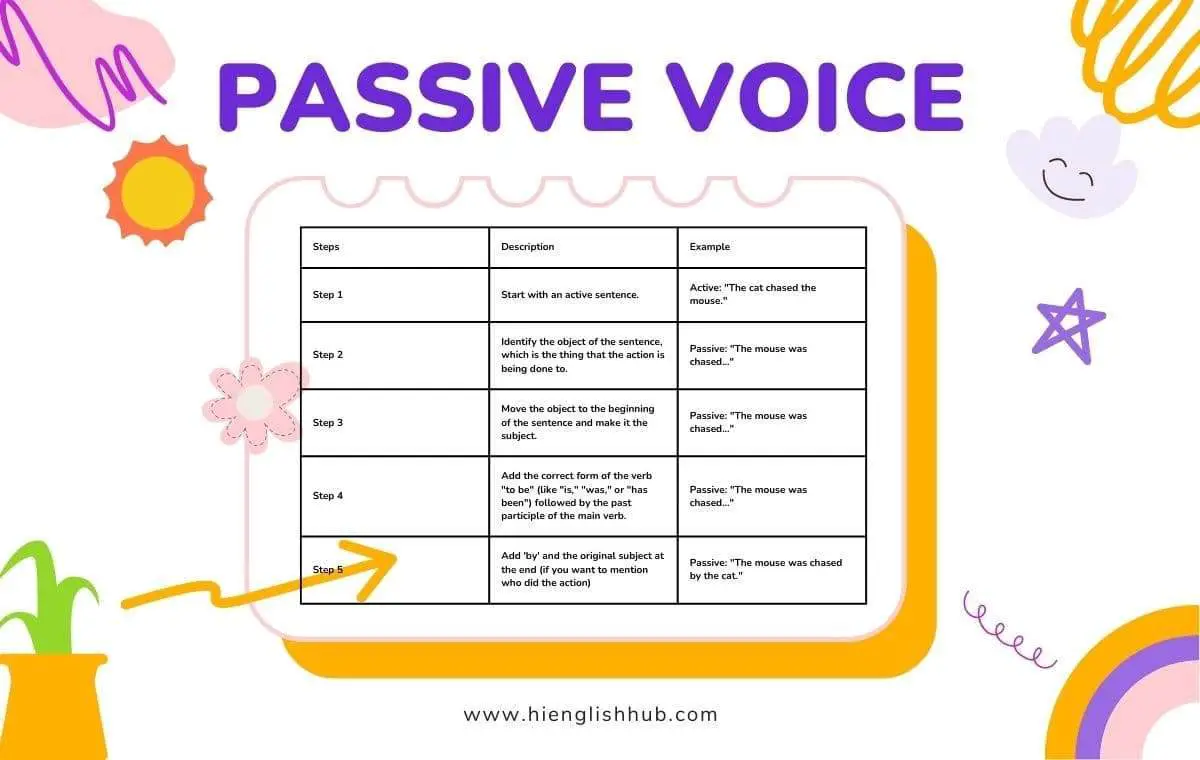Hey there, language lovers!
Ready for a deep dive into the intriguing world of the passive voice?
Buckle up because we’re about to unveil the mystery behind this often misunderstood part of English grammar.
By the end of this session, you’ll not only understand what the passive voice is, but you’ll also know when and how to use it effectively in your writing.
So, let’s get started!
What Is Passive Voice?
Imagine you and your friends are playing a game of catch in the park. You might say, “I threw the ball.” That’s what we call an active voice sentence because you (the subject) are doing the action.
But what if we flipped things around and made the ball the star of the sentence? We’d say, “The ball was thrown by me.” Suddenly, the ball is getting all the attention. This, my friend, is what we call the passive voice.
So, in the simplest terms, passive voice is when what’s usually getting the action turns into the one leading the sentence.
Whether it’s in day-to-day conversation, in an exciting novel, or even in a formal report, you’ll find the passive voice at work everywhere once you start looking for it.
Also read: Understanding Part Of Speech: A Beginner’s Guide
Active Voice Vs Passive Voice: What’s The Difference?
Let’s break down this whole active vs passive thing.
| Categories | Active Voice | Passive Voice | Examples Of Passive Voice |
|---|---|---|---|
| Clarity | Active voice is direct and clear. It tells the reader exactly who is doing what. | Passive voice can sometimes be less clear about who is performing the action. | “My bike was stolen.” (We don’t know who stole it.) |
| Formality | Active voice is less formal and often used in casual or conversational writing. | Passive voice can sound more formal or academic, making it a common choice in scientific or scholarly writing. | “The experiment was conducted carefully.” (Sounds like a science report, right?) |
| Emphasis | Active voice emphasizes the ‘doer’ of the action. It’s about who is performing the action. | Passive voice puts more emphasis on the action itself or the receiver of the action. It’s about what is happening. | “The gift was opened with excitement.” (The focus is on the action of opening the gift and the receiver’s reaction.) |
| Known/Unknown Doer | In active voice, the doer is known and is important to the context of the sentence. | In passive voice, the doer may be unknown, unimportant, or obvious from the context, so it’s often left out. | “A new record was set at the race.” (It’s more about the record, not who set it.) |
| Word Count | Active voice usually uses fewer words, making sentences more concise. | Passive voice often uses more words, as additional words are needed to indicate who or what is performing the action (if included). | “The cake was baked by John.” (6 words) |
| Responsibility | Active voice directly attributes actions, making responsibilities clear. | Passive voice can obscure responsibility, which can be useful if you want to avoid placing blame. | “Mistakes were made in the project.” (We’re not pointing fingers at any specific person or group. It could have been anyone involved in the project.) |
Easy Steps To Form A Passive Sentence
Making a sentence passive isn’t hard. Just follow these steps:
| Steps | Description | Example |
|---|---|---|
| Step 1 | Start with an active sentence. | Active: “The cat chased the mouse.” |
| Step 2 | Identify the object of the sentence, which is the thing that the action is being done to. | Passive: “The mouse was chased…” |
| Step 3 | Move the object to the beginning of the sentence and make it the subject. | Passive: “The mouse was chased…” |
| Step 4 | Add the correct form of the verb “to be” (like “is,” “was,” or “has been”) followed by the past participle of the main verb. | Passive: “The mouse was chased…” |
| Step 5 | Add ‘by’ and the original subject at the end (if you want to mention who did the action) | Passive: “The mouse was chased by the cat.” |
And there you have it! You’ve just made a passive sentence.
The Word ‘By’ In Passive Voice
You know how in a movie they always say, “Directed by…” before naming the director? That’s kind of how ‘by’ works in passive voice!
In passive sentences, we use the word ‘by’ when we want to tell who did the action.
So if your whole cake disappeared and you found out your brother was the culprit, you’d say, “The cake was eaten by my brother!” Here, ‘by’ helps us point out the sneaky cake-eater.
Just remember, ‘by’ is like the arrow that points to who did the action in a passive sentence.
Using Passive Voice In Different Tenses
| Tense | Passive Voice Example |
|---|---|
| Present Simple | Text abbreviations are frequently used by smartphone users in informal communication. |
| Present Perfect | Many songs have been sung by that famous singer. |
| Past Simple | The Truth or Dare questions were asked by the group during the party. |
| Past Perfect | All the tickets had been sold for the concert before we arrived. |
| Future Simple | A new skate park will be built in our neighborhood next year. |
| Future Perfect | By the end of the summer, all the books will have been read by the book club. |
Myths About Passive Voice
1. Passive voice is always wrong: Nope, that’s not true! Passive voice is just another way to structure sentences. It can be very useful in certain situations, like when the focus is on the action or the receiver of the action.
2. Using passive voice makes your writing weak: Not necessarily! Both active and passive voice have their strengths. It’s a way to change up your sentence structure and create different effects.
3. Passive voice should always be avoided: That’s a myth too! Sometimes passive voice is the best choice. It can be handy when you don’t know who did the action or when it’s not important to mention the doer.
4. Passive voice is always wordy: While passive voice can sometimes use more words, it’s not always the case. It depends on how you construct your sentence.
5. Passive voice is formal and boring: Not true! Passive voice can add variety and make your writing more interesting. It’s like adding a splash of color to your sentences.
6. Passive voice always hides the doer. While passive voice can sometimes omit the doer or make it less clear, it doesn’t always hide the doer. You can include the doer in a passive sentence if it’s important or if you want to give credit where it’s due.
Remember, using passive voice has its own purpose and can be used effectively in different situations. Don’t be afraid to explore and experiment with it!
Fun Passive Voice Exercises With Answers
Let’s have some fun with the passive voice. I’ll give you a sentence in the active voice, and your job is to switch it over to the passive voice. I’ll provide the answers too, but give it a shot first, okay?

1. Active: She wrote an interesting book.
Passive: ____________________________________
2. Active: My dog chased the postman.
Passive: ____________________________________
3. Active: The teachers will mark the exams next week.
Passive: ____________________________________
4. Active: The mechanic fixed my car.
Passive: ____________________________________
5. Active: The director will release the new movie next month.
Passive: ____________________________________
And here are the answers:
- Passive: An interesting book was written by her.
- Passive: The postman was chased by my dog.
- Passive: The exams will be marked by the teachers next week.
- Passive: My car was fixed by the mechanic.
- Passive: The new movie will be released by the director next month.
How did you do? Remember, the key to mastering the passive voice is understanding its structure and purpose: to emphasize the action, or the recipient of the action, rather than the doer of the action.
Quick Quiz: Test Your Passive Voice Skills
Now I’ll give you a sentence and your task is to identify whether it’s in active or passive voice. Ready?

- The movie was watched by millions of people.
- You should finish your homework.
- The award was won by the youngest contestant.
- Mom is baking an apple pie.
- A novel was written by the famous author.
Answers:
- Passive
- Active
- Passive
- Active
- Passive
Wrap-Up: Understanding Passive Voice Better
Whew! What a journey we’ve been on, huh?
We’ve unraveled the complexities of the passive voice together, and hopefully, it’s not as intimidating as it may have seemed at first.
The key takeaway here? Use the passive voice when the action is more important than who performed it or when you don’t know or want to hide who’s responsible. It’s all about adding variety to your writing and being intentional with your words.
Now that you’ve leveled up your passive voice skills, why not share this knowledge with your friends?
Sharing is caring, and your pals might also benefit from these handy grammar tips. Go ahead and click on that share button!
And don’t forget to follow Hi English Hub on Pinterest and Twitter for more exciting language adventures. I’m constantly bringing you all sorts of fun language and grammar tidbits to keep you sharp and savvy.
So, keep practicing, stay curious, and until our next linguistic deep-dive, happy writing, everyone!

